1
Go West -May 29, 1913 - The Signal -
"Mr. Sallows At Ottawa - R.R. Sallows, portrait and landscape photographer, was in Ottawa last week in conference with W.D. Scott, superintendent of the Department of Immigration for Canada, in regard to photographs which the Department wishes Mr. Sallows to secure for use in publicity work. As a result of the interview Mr. Sallows leaves on Friday on a six weeks' tour of the Prairie Provinces in search of the material required by the immigration authorities. While away last week Mr. Sallows also was in Montreal consulting with H.R. Charlton of the advertising department of the G.T.R., regarding a similar contract for work to be filled in the near future. The Signal hopes to give its reader some impressions of the Western country as viewed by Mr. Sallows during his trip across the prairies."
When Reuben Sallows got the contract to go West in 1913, he also pledged to write an account of his travels for the local Goderich paper, The Signal. What follows are the letters he wrote, with photographs he took on his trip.
2
"Western Notes", by Reuben R. Sallows, published in Goderich Signal on June 19, 1913R.R. Sallows, portrait and landscape photographer, who is away on a tour of the Prairie Provinces in the interests of the Department of Immigration at Ottawa, writes to The Signal from Regina, Saskatchewan. His letter contains a running account of his "doings," since he left Goderich three weeks ago. It is as follows:
"I left Goderich via CPR on the afternoon of Friday May 30th. As I proceeded eastward through the fine farming communities and noted the orchards with their luxuriant burdens of blossoms, the handsome residences and the capacious farm buildings, I wondered, as I have often done, why so many people are induced to leave such a splendid Province for mixed farming and fruit growing as Ontario has been proved to be for less congenial environments in the West.
Leaving Toronto that evening we reached Sudbury on Saturday morning about 7 o'clock. From this point west to Port Arthur the country is the abomination of desolation spoken of by the Prophet Daniel. It is all fire swept, leaving only the bare rocks to be seen for miles. In some places however, second growth - pine and poplar is making a start. From Sudbury to Port Arthur the CPR has large gangs of men preparing for the double-tracking of the system between these two points. This work between Port Arthur and Winnipeg is already completed. A derailed freight train delayed our arrival at Winnipeg for five hours and on occasion the leisurely jaunting along the railway of a big moose rendered necessary the application of the emergency brakes. Two weeks previously a moose was killed near the same place.
We reached Winnipeg six hours late. I spent Monday morning interviewing immigration officials and receiving instructions as to the route I should take in order to obtain the best results for the Department. In the afternoon, Mr. McKenzie, manager and sales agent for the McLaughlin Company of Ottawa, took me for a ride through the parks and residential district.
The word Winnipeg is derived from the Indian Cree name given to the lake forty miles north: "Win" meaning murky and "nipeg" meaning water.
The city has a fine street railway service. It is said to be the only city which is favored with a raised wooden platform (six feet wide, fifty feet long and six inches high) for the convenience of the street railway patrons. While waiting for cars the people stand on these platforms and are thus secure from passing vehicles.
The city has a very low rate for lighting - only three cents per kilowatt. The question of bringing the water supply from Shoal Lake, eighty miles away, is now receiving consideration. The necessary expenditure is estimated at $11,000,000 but the city would be recompensed in a large measure by securing a splendid supply of pure water.
Everywhere about the city improvements are being made. In the building trade the Hudson's Bay Co. leads by contracting for the erection of a new store at a cost of $3,000,000.
The foreign element is much in evidence on the streets and at the present time many men are out of employment.
3
CarmanOn Tuesday I took the morning train for Carman. Much of the grain was sprouted and looked fine, while a number of the farmers were just finishing their seeding operations. I was much astonished at the number of farm implements which had been left out in the fields since last harvest-time. At some places the binder was standing just where the last sheaf was cut, and as many as four and five of these harvesting implements were to be seen together on other farms. Owing to the wet weather of last year much flax and other grains are still standing and will be a total loss. I also noticed that the Manitoba farmers have invested largely in galvanized iron granaries. They are mounted on skids, so that they can be hauled to any point at threshing time. The capacity of the ordinary-sized ones is 1,000 bushels.
Reaching Carman, I was met at the station by the chairman of the Board of Trade and members of the Publicity Bureau of the town. After dinner, the chairman with two others and myself made a tour of the southern section of the country in an automobile. We covered about forty miles and took photographs of homes of the early settlers. When they first located there the pioneers in this district had Winnipeg as their postoffice - a distance of fifty-seven miles away. They are numbered among those who have "made good." Some of them started with scarcely a shoestring and they are now independently rich.
"Like many an Ontario town today, Carman is losing its population. At one time it had over 2,000 of a population, which has dwindled down to 1,200. I counted thirteen empty stores in town.
4
Mr. William's old house, Carman, Manitoba1913
Carman, Manitoba
 Credits:
Credits:Library & Archives Canada, Ottawa, Ontario
5
Andrew Grayman's residence in Carman, Manitoba1913
Carman, Manitoba
 Credits:
Credits:Library & Archives Canada, Ottawa, Ontario
6
Brandon, ManitobaReaching Brandon on Wednesday, C.W. Spears met me at the station and in the afternoon we drove south of Brandon through a fine farming district. The next day we went north of the city and secured several good farming views. After dinner J.D. McGregor took us out in his auto to his stock farm about ten miles northwest of Brandon. This farm is equipped with the finest barn and other buildings that I have ever seen. He has a fine hog pen over 100 feet long. There is a passage down the center and on either side are pens 10x12 in dimensions. At the back of each separate pen there is a raised platform, about four feet high, for sleeping quarters. At the exhibition in Chicago last year Mr. McGregor captured the sweepstakes prize for his Angus cattle.
Brandon is a fine, growing city with a population of 17,000. A street car system was installed recently and when the city advertised for twenty men to act as conductors and motormen they had 280 applications for the positions. Three or four real estate men who started in business last year are now delivering groceries. This will give you some idea of the present conditions out there.
Brandon is the distributing center for several manufacturers and at the present time I saw stored near the station over $300,000 worth of implements.
7
Rural school near Brandon, Manitoba1913
Brandon, Manitoba
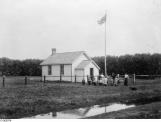 Credits:
Credits:Library & Archives Canada, Ottawa, Ontario
8
C.W. Speer's homestead, Brandon, Manitoba1913
Brandon, Manitoba
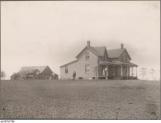 Credits:
Credits:Library & Archives Canada, Ottawa, Ontario
9
J.D. McGregor's old home, Brandon, Manitoba1913
Brandon, Manitoba
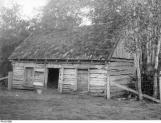 Credits:
Credits:Library & Archives Canada, Ottawa, Ontario
10
J.D. McGregor's new barn, Brandon, Manitoba1913
Brandon, Manitoba
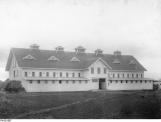 Credits:
Credits:Library & Archives Canada, Ottawa, Ontario
11
$300,000 worth of farm equipment, Brandon, Manitoba1913
Brandon, Manitoba
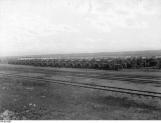 Credits:
Credits:Library & Archives Canada, Ottawa, Ontario
12
Griswold, ManitobaOn Friday, Mr. Speers drove me thirty miles west to Griswold. We secured photographs of several good farm residences on the way. In the afternoon I hired an auto and started north, passing through the Indian Reserve near Griswold. Travelling over an old prairie trail we ran over and killed a number of gophers. These little animals frequently do serious damage to the grain crop unless preventive measures are taken to get rid of them by the poison route.
After traveling about thirty miles north we turned west, reaching Lenore in the evening. The Manitoba demonstration train was there and seemed to be well patronized. Potatoes are selling there for twenty cents per bushel. The wheat crop in that section is estimated to average about fifteen bushels per acre. After paying all expenses the farmer will have cleared about $6 per acre.
Leaving Lenore I drove south to Virden and from that station took the train for Regina. From Indian Head to Regina we passed through a fine prairie country and as far as the eye could see it was simply land and sky."
13
R.J. Stewart's farm, Griswold, Manitoba1913
Griswold, Manitoba
 Credits:
Credits:Library & Archives Canada, Ottawa, Ontario
14
Grain elevators at Indian Head, Saskatchewan1913
Indian Head, Saskatchewan
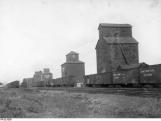 Credits:
Credits:Library & Archives Canada, Ottawa, Ontario